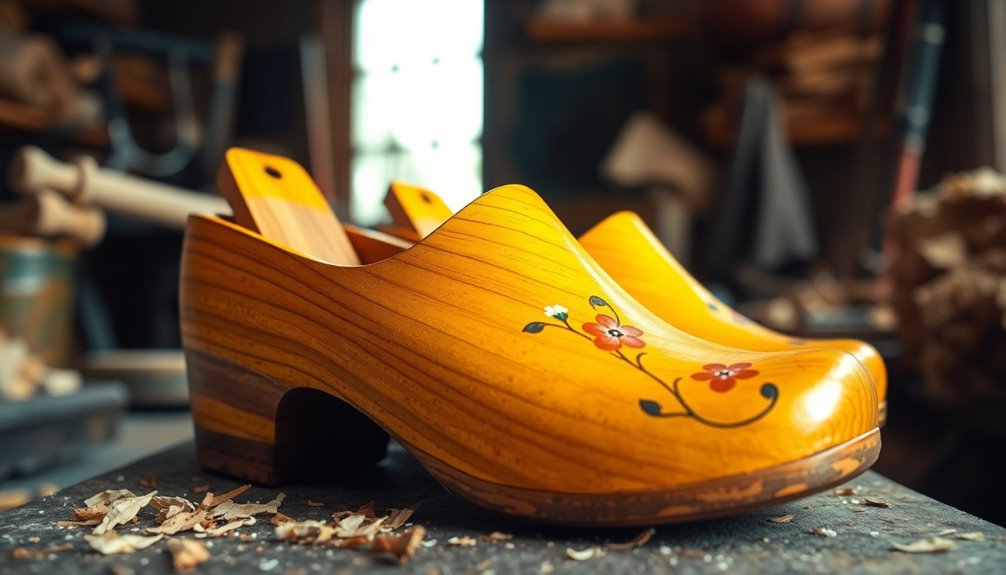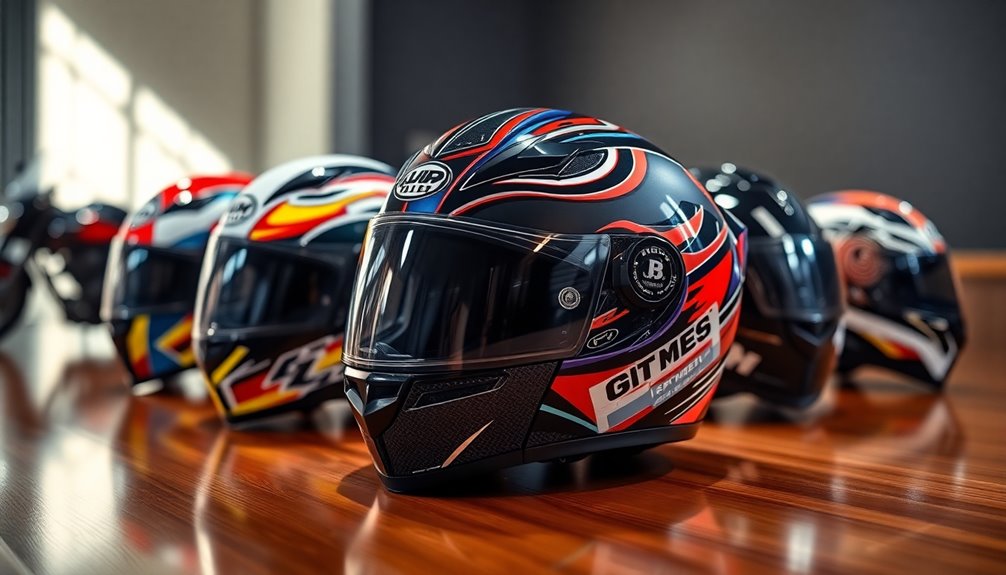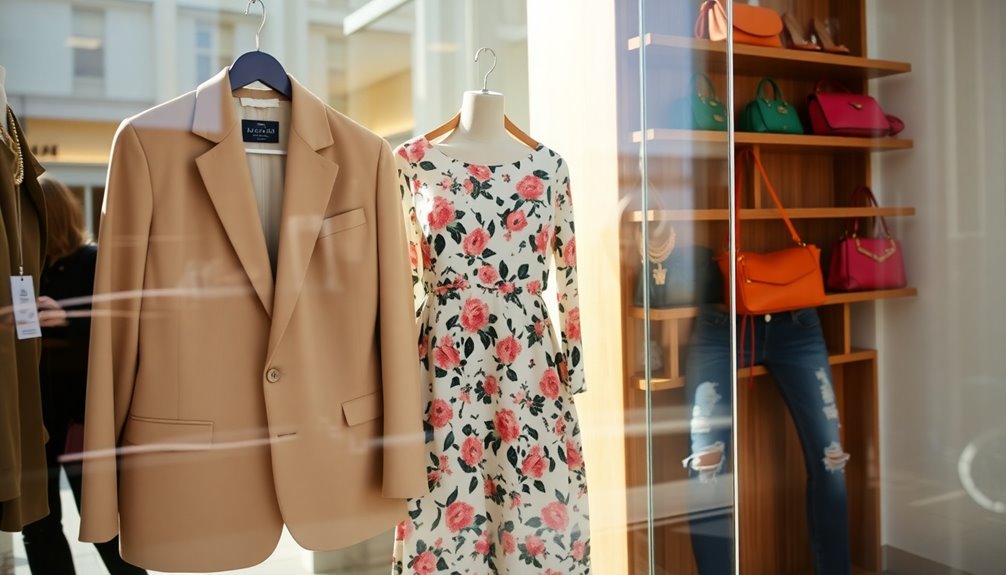When you think of wooden shoes from the Netherlands, vivid images of Dutch craftsmanship come to mind. These iconic clogs, rooted in history since the 13th century, showcase not just practicality but also artistry. Skilled artisans, known as bodgers, create each pair using durable woods like poplar and willow, ensuring they stand the test of time. While they began as functional footwear for farmers, today they symbolize Dutch culture and tradition. Whether for gardening or as colorful souvenirs, these shoes connect you to a rich heritage. There's even more to discover about their role in modern Dutch life and craftsmanship.
Key Takeaways
- Wooden shoes, or klompen, have a rich history in the Netherlands, symbolizing agricultural heritage and craftsmanship since the 13th century.
- Crafted from durable woods like poplar and willow, clogs are designed for functionality and comfort in muddy conditions.
- Traditional clog-making techniques are passed down through generations, ensuring quality and unique regional designs in each pair.
- Clogs remain culturally significant, often featured in Dutch traditions, weddings, and cultural events, reflecting vibrant Dutch identity.
- Tourist attractions, such as workshops and museums, offer insights into clog craftsmanship, promoting appreciation and sustainability of this traditional art.
History of Wooden Shoes
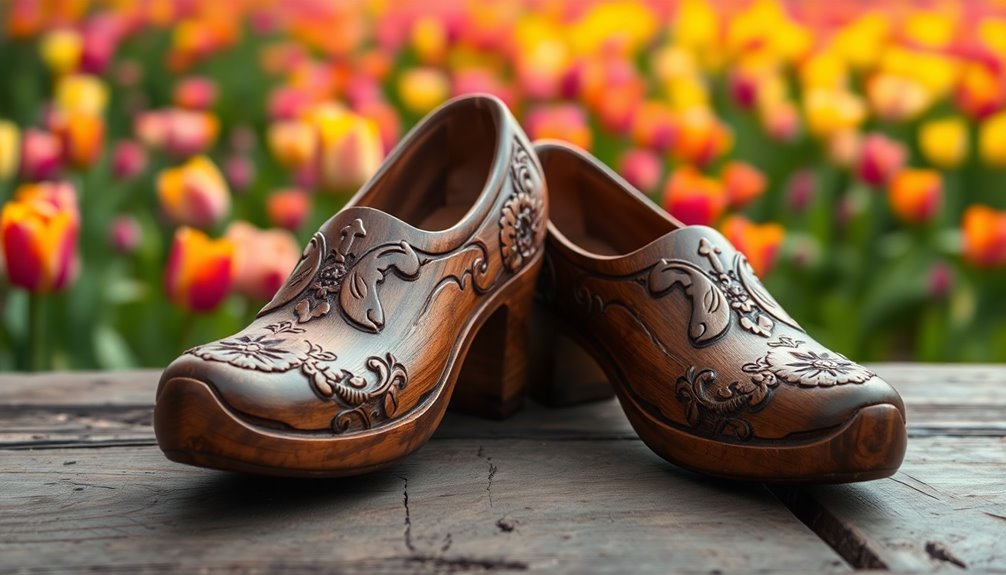
The enduring charm of wooden shoes, or clogs, stems from their rich history that dates back to the 13th century in the Netherlands. You'll find the earliest known examples in a peat bog in Drenthe, where these shoes were primarily worn by farmers, fishermen, and the working class.
Crafted from a single piece of wood, they were shaped to fit your foot and secured with leather straps, offering excellent protection against wet and muddy conditions.
During the 16th and 17th centuries, wooden shoes gained immense popularity due to the agrarian economy and the need for durable footwear in the damp Dutch climate. Their affordability made them a practical choice for the poorer class, and they became essential for various outdoor workers, including sailors and woodcutters. Common woods for soles included willow, poplar, and ash, which were easily sourced in the Netherlands.
Naturally water-resistant, these clogs allowed you to traverse sodden ground effortlessly.
As industrialization took hold in the 18th and 19th centuries, wooden shoe production evolved, incorporating machines for efficiency.
While the traditional craftsmanship faced challenges, the cultural significance of wooden shoes as symbols of Dutch heritage endures, connecting you to a rich historical narrative that still resonates today.
Craftsmanship and Materials

Craftsmanship in wooden shoe production showcases the artistry and skill of clog makers, also known as "bodgers." These artisans pass down their techniques through generations, ensuring that each pair of clogs reflects their expertise and dedication.
The process begins with selecting the right type of wood, typically poplar due to its hardness and lightness, but you might also encounter willow, alder, or sycamore. These woods are naturally water-resistant, perfect for the Dutch climate.
Once the wood is chosen, it's cut into logs and split into smaller pieces. Using hand-operated machines, the clog maker carves and shapes the wood to fit your foot. They hollow out the interior using drills and sharp knives, ensuring a comfortable fit.
After shaping, sandpaper belts smooth the surfaces for a refined finish. The wood is then air-dried for a few weeks to harden, enhancing its durability. This process reflects the traditional craftsmanship that has been preserved in the Netherlands.
Finishing touches are applied by hand, preserving the traditional look while adding modern comforts. Some shoes are painted and varnished for weather resistance, and decorations may signify special occasions.
This blend of tradition and innovation makes each pair of wooden shoes a unique piece of craftsmanship.
Manufacturing Techniques
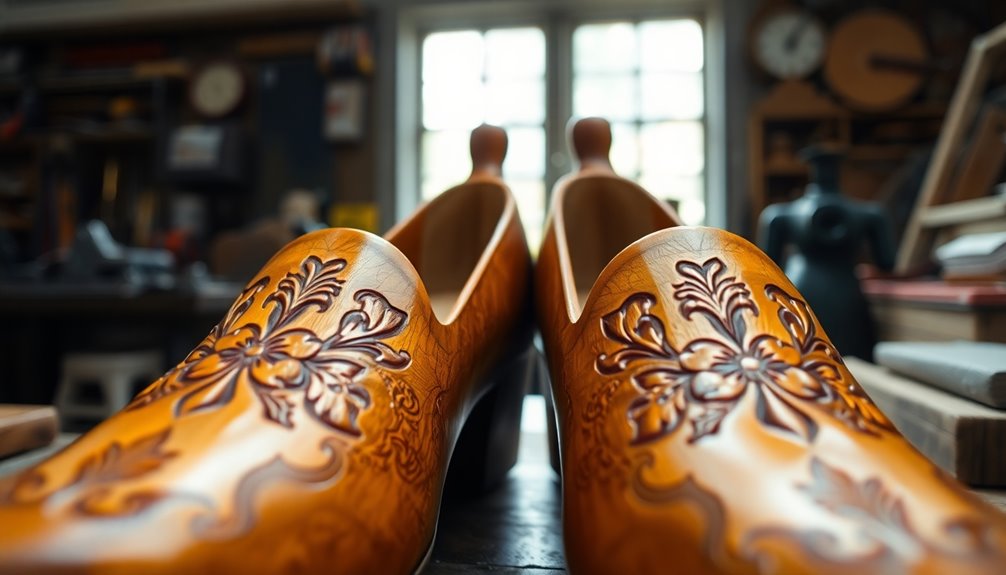
Utilizing traditional methods and modern technology, clog makers meticulously follow a series of precise manufacturing techniques to create wooden shoes.
First, they select the right tree trunks, focusing on size and shape, and cut them into logs. These logs are split into smaller pieces, examining branches and bark for ease of splitting. The preferred woods—poplar, willow, and alder—are divided into equal pieces, called spheres or blanks.
Next, large pieces are shaped roughly into a shoe form using a special axe or hand-operated machines. Dunking the wood in water prevents splintering during this process. Trimming removes the bark, revealing the clog's shape, while machines help carve the final shoe outlines. Holes are drilled with precision, ensuring the clogs stay secure.
In the hollowing stage, a drill creates space inside the shoe, and sharp knives refine the heel and nose. Sandpaper belts smooth every edge for comfort. The craftsmanship involved in this process highlights the traditional techniques that have been passed down through generations.
After shaping, clogs are hand-sanded, air-dried, and painted if desired. A matte lacquer adds weather resistance, and each pair is custom-finished, ensuring that every clog is ready for use, just as it's been for generations.
Cultural Significance

Rooted deeply in Dutch history, wooden shoes, or "klompen," symbolize more than just footwear; they embody a rich cultural heritage. Dating back to the 13th century, these handmade shoes were initially crafted by farmers and fishermen to protect their feet from harsh conditions and rugged terrain.
The materials used—alder, beech, and sycamore—highlight the practical origins of klompen, designed for stability and safety rather than style. Additionally, the Holland Travel Ticket offers visitors the chance to explore the significance of these shoes in various regions across the Netherlands.
Today, wooden shoes are a proud expression of Dutch identity. Adorned with bright colors and intricate designs, they serve as a canvas for cultural expression. You'll find klompen at weddings and churches, showcasing their significance in Dutch traditions.
Clog dancing, a vibrant celebration of the Dutch spirit, further emphasizes their cultural roots.
Though their everyday use has diminished, wooden shoes remain relevant in rural areas and as part of traditional costumes. They stand as symbols of resilience and heritage, reminding you of the craftsmanship and history behind each pair.
As you explore the Netherlands, you'll see how klompen continue to weave into the fabric of Dutch culture, bridging the past with the present.
Modern Applications
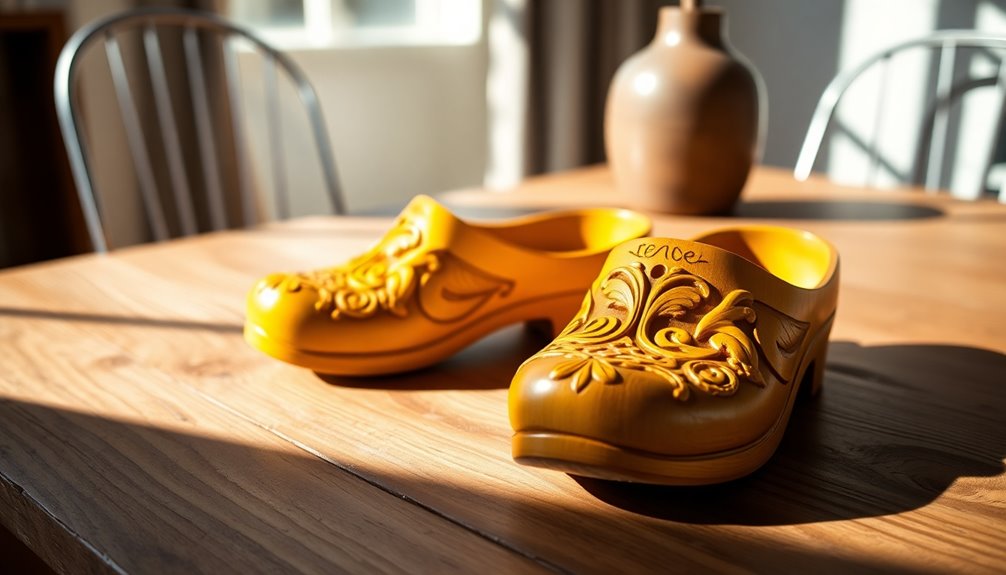
Wooden shoes continue to find their place in modern life, blending tradition with contemporary needs. In rural areas, you might still spot farmers and gardeners wearing them for protection and stability in muddy conditions.
They're also practical for bridge maintainers who use them while collecting dues in smaller waterways. Some even fill wooden shoes with house-leeks to prevent lightning strikes on farms.
Beyond their practical uses, these shoes have become decorative items as well. You can find them painted in bright colors and adorned with intricate designs, often sold as souvenirs featuring popular themes or brands. Notably, clogs serve as souvenirs that highlight the cultural significance of Dutch craftsmanship.
Creative embellishments like carvings and bells add a charming touch, while ceramic versions serve as stylish decor.
Modern adaptations have embraced eco-friendly materials and manufacturing methods, reducing environmental impact. You can choose from different sizes and even plastic versions for versatility.
Some designs now feature interchangeable uppers and enhanced comfort, like air circulation, to keep your feet cool.
Whether used for gardening, as decorative pieces, or even in cultural events, wooden shoes show that they remain relevant in today's world, enhancing both function and style.
Preservation and Tourism
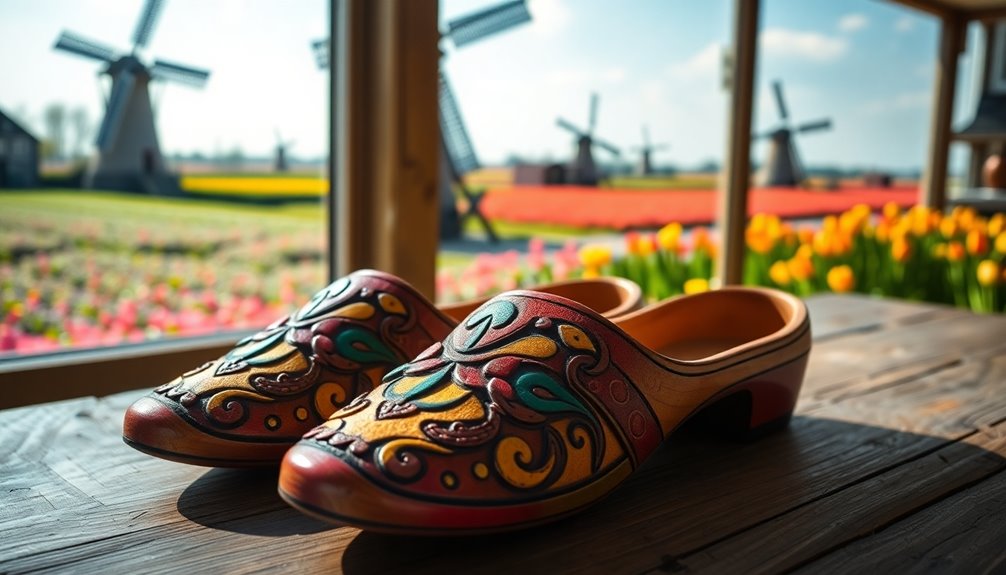
The preservation of traditional craftsmanship in wooden shoe making is crucial to maintaining Dutch cultural heritage. Wooden shoes have been integral to the Netherlands since the 13th century, but with only about a dozen clog producers still active, the art is at risk.
The Kooijman Wooden Shoe Workshop stands out, showcasing restored antique machines to keep traditional techniques alive. In fact, clogs are naturally water-resistant, making them practical for various environments and further emphasizing their historical significance.
Tourism plays a significant role in this preservation effort. As visitor numbers surged from 11 million to 18 million over the past decade, the demand for wooden shoes as souvenirs has also increased. This interest helps sustain the production of these cultural icons.
Attractions like the Kooijman Workshop and the De Zaanse Schans Museum not only display the history of clogs but also educate visitors about their significance.
You can explore the International Wooden Shoe Museum in Eelde, which boasts an extensive collection showcasing the craft's evolution.
By engaging with these sites, you contribute to the ongoing preservation of wooden shoe making, ensuring this unique aspect of Dutch identity endures for future generations.
Embrace this opportunity to appreciate and support the timeless craftsmanship behind wooden shoes.
Frequently Asked Questions
How Do I Properly Care for Wooden Shoes?
To properly care for your wooden shoes, start by wiping off dirt with a damp cloth.
For stubborn stains, use soapy water and a sponge, but don't soak the wood.
Air dry them away from heat and sunlight.
Once dry, apply a thin layer of wood care or baby oil to protect the surface.
Store them in a dry place and regularly clean them to maintain their appearance and longevity.
Can Wooden Shoes Be Customized for Personal Designs?
Yes, you can definitely customize wooden shoes for personal designs!
Many options are available, such as engraving your name or a special message, choosing from traditional or modern painted designs, and selecting colors that match your style.
You might even find unique embellishments to add a personal touch.
Whether you want them for yourself or as a gift, customizing wooden shoes makes them truly one-of-a-kind and meaningful.
Are Wooden Shoes Available in Different Sizes for Children?
Yes, wooden shoes are available in various sizes for children, ranging from EUR 19 to 30.
To ensure a perfect fit, you should trace your child's foot on paper and measure the outline in centimeters.
Remember to add 1 cm for comfort and check that there's a gap about the width of a thumb between the heel and the shoe's back.
If you're unsure, don't hesitate to contact the vendor for guidance.
Where Can I Purchase Authentic Wooden Shoes Online?
You can purchase authentic wooden shoes online from several reputable sources.
Check out Hollands Klompenhuis for a wide range of colors and designs, or visit Dutch Gift Outlet for their 30-day return policy.
Dutch-Clogs.com offers traditional clogs often made by hand, while Cloggieshop specializes in detailed replicas and souvenir shoes.
Each site provides unique options, ensuring you find the perfect wooden shoes to suit your style and needs.
Do Wooden Shoes Come in Different Colors and Finishes?
Yes, wooden shoes come in various colors and finishes!
You'll find traditional shades like yellow and black, often adorned with floral patterns or varnished for special occasions.
Modern designs feature vibrant colors, including tulips and windmills, or artistic touches like Delfts Blue.
You can even customize them to match your style.
With options for adults and children, there's a perfect pair for everyone, catering to both traditional and contemporary tastes.
Conclusion
In conclusion, wooden shoes from the Netherlands embody a rich history and skilled craftsmanship that you can appreciate today. Their timeless appeal goes beyond functionality, connecting you to Dutch culture and traditions. Whether you're wearing them or displaying them, these iconic clogs serve as a reminder of the artistry and heritage that shaped them. So, embrace the charm of wooden shoes, and let them add a unique touch to your life and travels.
